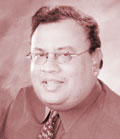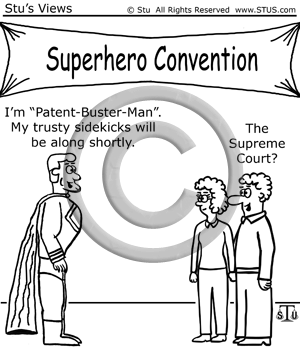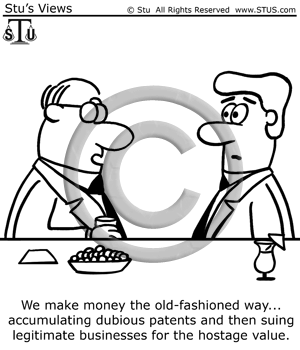May 2007
CAFC Affirms Disqualification of Defendant’s Attorneys
In re Hyundai Motor Am., 185 Fed. Appx. 940 (Fed. Cir. 2006)
Orion IP has accused dozens of companies of infringement of its business method patents ("computer-assisted sales"). At one point, Orion worked with the Orrick firm on some matters and Orrick made a pitch to handle Orion's litigation and patent strategy work. Orion demurred. Once litigation began, Orrick got back in the game by agreeing to represent several of the accused infringers directly adverse to Orion.
The Texas district court noted a conflict-of-interest and disqualified Orrick. On writ of mandamus, the CAFC affirmed -- finding no error.
The parties apparently presented diverging evidence as to the subject-matter of early meetings between Orrick and Orion and the type of documents exchanged. The CAFC noted that these were purely factual questions that the lower court "resolved in Orion's favor" without any clear error.
In order to prevail, Hyundai must clearly and indisputably show clear error in the district court's findings of fact and application of the facts to the law. Hyundai has not carried its burden. This is essentially a factual dispute, which the district court resolved in Orion's favor. The district court held a hearing, considered the competing declarations, and reviewed the pertinent documents. We do not find a basis for overturning those findings.
Disqualification affirmed.
To continue reading, become a Patently-O member. Already a member? Simply log in to access the full post.
Watch-Out!: Bleed-through Claim Construction and Argument Estoppel
To continue reading, become a Patently-O member. Already a member? Simply log in to access the full post.
Patently-O TidBits
To continue reading, become a Patently-O member. Already a member? Simply log in to access the full post.
Book Review: Fundamentals of Claim Drafting
To continue reading, become a Patently-O member. Already a member? Simply log in to access the full post.
USPTO Issues Preliminary Obviousness Examination Instructions
To continue reading, become a Patently-O member. Already a member? Simply log in to access the full post.
Impact of KSR v. Teleflex on Pharmaceutical Industry
For the past 30 years, Cal has been a litigation analyst serving the investment community. He is member of the New York Bar and a graduate of Northwestern law School. www.litigationnotes.com.
=====================
By Cal Crary:
We do not believe that too much guessing is needed to see what the new patent environment will be like, since we already have the benefit of Chief Judge Michel’s March 23, 2007 decision in the Norvasc case, in which he identified the likely changes in the court’s obviousness jurisprudence. . . . A few of the principles reflected in Judge Michel’s opinion are as follows:
- routine testing to optimize a single parameter, rather than numerous parameters, is obvious;
- an approach that is obvious to try is also obvious where normal trial and error procedures will lead to the result;
- unexpected results cannot overcome an obviousness challenge unless the patentee proves what results would have been expected;
- a reasonable expectation of success does not have to be a predictable certainty but rather it can be an expectation that can be satisfied by routine experimentation; and
- motivation can be found in common knowledge, the prior art as a whole or the nature of the problem itself.
....
[T]here are certain types of patents in the pharmaceutical industry that will have to be looked at, or looked at again, in light of the Supreme Court’s opinion. We happen to believe that enantiomer patents are especially vulnerable, at least in cases in which the technology to separate them was available in the public domain at the time the separation was made. However, we do not believe that the courts will permit a massive extermination of drug industry patents or that a meat-axe approach to them will be used. Rather, we think the Supreme Court’s only demand is that common sense be injected into the determination of what a person of ordinary creative skill in the art would do. The primary examples of enantiomer patents that we regard as vulnerable include Forest Labs’ Lexapro, Bristol-Myers’ Plavix, AstraZeneca’s Nexium and Johnson & Johnson’s Levaquin. We think that all four of these drugs are especially vulnerable now, in light of the new, broader scope of obviousness. In the case of Levaquin, Mylan Labs lost at the district court level in a case that it should have won, even under the law as it existed at the time, and then it was affirmed by Judge Pauline Newman, a pro-industry Federal Circuit judge, in a non-precedential decision without opinion. In a new case, if obviousness is in the mix and if Judge Newman is avoided on appeal, then Levaquin will be a generic drug.
To continue reading, become a Patently-O member. Already a member? Simply log in to access the full post.
KSR and the F-Words
Now that the Supreme Court has issued its opinion in KSR v. Teleflex, the first reaction is what took it so long? During the past six months since oral arguments in late November, I was expecting that the Court was taking its time crafting a historical opinion that delved into the genesis and evolution of the nonobviousness doctrine since the Hotchkiss decision in 1851. The Court does mention the Hotchkiss decision and a few others, but the six month gestation has yielded a compact, thirty page decision that can be summarized with three simple F-words: formalism, functionality, and flexibility.
To continue reading, become a Patently-O member. Already a member? Simply log in to access the full post.
Patently Funny
Cartoons via Stu Rees at www.stus.com. (Used with permission).
To continue reading, become a Patently-O member. Already a member? Simply log in to access the full post.
KSR v. Teleflex: A Tale Full of Sound and Fury, Signifying Little?
By Professor Gregory Mandel
Though the Supreme Court’s unanimous reversal in KSR v. Teleflex, No. 04-1350, 550 U.S. ___ (2007), contains some harsh words for the Federal Circuit’s teaching, suggestion, or motivation (TSM) test, the decision itself appears to leave the TSM requirement roughly intact. Justice Kennedy’s opinion emphatically rejects an 'explicit' TSM test—one that would require explicit prior art teachings in order to combine given references in the obviousness analysis. At the same time, the decision appears to essentially recreate the 'implicit' or 'flexible' TSM test—one that would allow implicit suggestions, such as the nature of the problem, to provide the requisite motivation to combine. It is this implicit TSM requirement that represented current Federal Circuit doctrine, pursuant to several decisions published after certiorari was granted in KSR (e.g., In re Kahn, DyStar, & Alza). In fact, the Supreme Court even indicates that the Federal Circuit may have gotten it right in these post-cert cases. The KSR opinion is more a critique of the Circuit's application of the obviousness (and TSM) standard to the specific facts in  KSR than a critique of the need to rigorously (and expansively) evaluate what would lead a PHOSITA to combine certain references in the obviousness analysis.
KSR than a critique of the need to rigorously (and expansively) evaluate what would lead a PHOSITA to combine certain references in the obviousness analysis.
Under KSR, in order to evaluate whether a given combination was obvious, the factfinder must "determine whether there was an apparent reason to combine the known elements in the fashion claimed by the patent at issue." The Supreme Court’s "reason to combine" sounds significantly like "suggestion, teaching, or motivation to combine." It is interesting that the Court used a term as loose as “reason,” given concerns raised during oral argument about the indefiniteness of the term “motivation.” In addition, the Court requires that, "[t]o facilitate review, the analysis should be made explicit," a proposition for which the Court cites Kahn, warning that conclusory statements are not sufficient. The Court goes on to criticize rigid application of TSM, particularly relying solely on published articles and explicit content of issued patents. But, the Court notes, "In the years since the Court of Customs and Patent Appeals set forth the essence of the TSM test, the Court of Appeals no doubt has applied the test in accord with these principles in many cases. There is no necessary inconsistency between the idea underlying the TSM test and the Graham analysis." And, the Court explicitly notes that the post-cert Circuit cases were not before it: "The extent to which [DyStar and Alza] may describe an analysis more consistent with our earlier precedents and our decision here is a matter for the Court of Appeals to consider in its future cases." The opinion also clearly (appropriately in my opinion) invites greater analysis of the PHOSITA and the circumstances surrounding the PHOSITA and the pertinent technology than the Circuit has engaged in in some of its decisions.
To continue reading, become a Patently-O member. Already a member? Simply log in to access the full post.
Senate Considers Reforms to Importation Rules
To continue reading, become a Patently-O member. Already a member? Simply log in to access the full post.
Microsoft v. AT&T: Extraterritorial Enforcement of US Patents
Microsoft Corp. v. AT&T Corp., 550 U. S. ____ (2007).
In a 7-1 decision, the Supreme Court held that Section 271(f) of the Patent Act does not extend to cover foreign duplication of software.
There is no such thing as a world-wide patent. Rather, patent law is territorial. A US patent covers infringing acts that occur in the US but generally disregards extraterritorial activity. The lone statutory exception is Section 271(f) of the Patent Act, which calls for infringement liability for the unauthorized supply of "components" of a patented invention for "combination" abroad.
Todays business reality has considerably dulled the teeth of 271(f) in the area of manufacturing -- few physical components are shipped abroad from the US. Through Microsoft and others, the US continues to be a leader in software development and the export of software. Of course, Microsoft does not export its software by loading millions of CDs on a cargo ship. Rather, it sends only a few copies to foreign OEM distributors who load copies of the software onto PCs for sale.
AT&T is the assignee of a patent covering a computer for encoding and compressing recorded speech. In the US, a computer with Microsoft WIndows installed infringes the patent. The question in this case, is whether the foreign installed software can be considered a "component" supplied from the US under 271(f).
The question before us: Does Microsoft's liability extend to computers made in another country when loaded with Windows software copied abroad from a master disk or electronic transmission dispatched by Microsoft from the United States? Our answer is "No."
As can be seen from the various amici briefs, reasonable minds can differ regarding two statutory elements: (1) whether software -- without being tied to a physical medium -- can be classified as a "component;" and (2) whether the foreign-made copy was "supplie[d]" from the US. Abiding by its principle against extraterritorial application of laws -- especially patent laws -- the Supreme Court answered both of these questions in a restrictive fashion:
- Abstract Software: Until it is expressed as a computer-readable "copy," e.g., on a CD-ROM, Windows software indeed any softwaredetached from an activating medium remains uncombinable. . . . Abstract software code is an idea without physical embodiment, and as such, it does not match §271(f)'s categorization: "components" amenable to "combination." [DDC: Software is never without a physical embodiment?]
- Supply of Copies: [T]he very components supplied from the United States, and not copies thereof, trigger §271(f) liability when combined abroad to form the patented invention at issue. Here, as we have repeatedly noted, the copies of Windows actuallyinstalled on the foreign computers were not themselves supplied from the United States. [Therefore no liability for foreign-made copies]
Dissent by Justice Stevens: In my view, Justice Stevens - in a solo dissent - has the more sensible view of component.
[I]f a disk with software inscribed on it is a "component," I find it difficult to understand why the most important ingredient of that component is not also a component.
To continue reading, become a Patently-O member. Already a member? Simply log in to access the full post.


